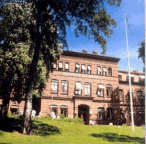
My Pallidotomy in Sweden
LINKS BACK TO: PALS Pages Index | Front Page | PD Information | Brainteasers
|
BACKGROUND
In 1993, I began to get rigidity in my right leg. My quality of life was
very poor. If I went for a walk,
as my leg would buckle up under me like a marionette on a string. I sometimes ended up
sitting on footpaths and in doorways.
I still took on the Captaincy of my Golf Club, and I surprised even myself at the
number of duties I was able to perform!
By 1996, my walk was badly affected. My right leg would draw up and inwards, and I
regularly got stuck, unable to move the leg. My children used to call me "Herr Flick" (the Nazi character
i n the popular tv programme "Allo Allo"). Because of my difficulties with walking, I had to stop playing my beloved golf.
I had not heard of any operations for PD at this stage, but my sister-in-law, who is a
doctor in Chicago, told me about operations for PD which were becoming more
popular because of problems with medications which could develop over time. One of her
colleagues was a neurosurgeon who was a friend of Dr. Laitenen in Sweden, and
he had recommended that, if my movements were restricted, I should go there for
an operation. My sister-in-law
advised me to go for it!
BECOMING INFORMED, MAKING DECISIONS
I wrote to Dr. Laitinen in Stockholm, a world-renowned neurosurgeon who specialised in
the surgical treatment of PD. His successor, Mr. Marwan Hariz responded to my
letter, and indicated that I would need a
video of myself, along with a letter of referral from my neurologist.
My neurologist at the time was not encouraging and felt it would be a waste of money.
I felt however that it was my PD and my risk, and that I was going to the best place
at the time.
My neurologist, despite his misgivings, filled in the referral form for me.
SWEDEN HERE I COME
In hospital the next day, they checked "bleeding time" - the time it took for
a sample of my blood to clot and I had a MRI scan. I was feeling nervous but positive.
FITTING THE FRAME
My first challenge came when it was time to
fit the stereotactic frame on my head, which would hold my head absolutely
rigid for the operation. I must admit I was very uncomfortable while
it was being fitted - basically bolted onto the head, despite a local anesthetic being used.
Once it was fitted however,
I felt better.
Another MRI scan was done, and Mr. Hariz used this to help him calculate exactly
where the target for the operation would be.
In the operating theatre, two visiting neurologists asked my permission
to observe the procedure. The first, a Mr. Janssen from The Netherlands, had accompanied
a patient of his to Stockholm for a pallidotomy.
He was eager to observe the effects of the operation on another
person. The second was from Croatia, and joked about how he and I were both from
war zones. The Dutch neurologist held my hand during the operation - at this stage I was very nervous. I was
almost at the point of no return! I was completely off medicine at this stage.
THE OPERATION
I was put on a glucose drip to help keep up my energy levels.
I was awake during the operation, which took all of fifteen minutes!
It was performed using local
anesthetic. A hand-held drill was used to bore a hole in the skull. I could feel the drill,
and at this stage my anxiety level was very high.
At that instant, the tremors stopped as though someone had switched off the
lights.
"Another operation that went right", Mr. Hariz said.
I spent a total of two days at the hospital, and spent the next four days at the hotel
before returning home. My head hurt, but less so as the days and weeks passed.
THE RECOVERY
I was advised to avoid any excessive physical efforts for a couple of weeks
after the surgery, and to get plenty of rest. No alcohol was allowed for two weeks after surgery, and
I could take Paracetamol for the pain. I kept in contact with Mr. Hariz by letter.
When I needed to find someone to take the stitches out back in Ireland, I did so with
difficulty. These operations were not known of outside neurological circles.
After the operation I had a very sore head! I was in awe of the whole operation, and very elated.
POST-OPERATIVE CONDITION
This operation gave me back my life. I was able to play golf again for a few years.
The greatest positive impact of my operation was on the quality of my walk.
CONCLUSION
I am aware that an operation for PD only disguises symptoms for a time, and is not a cure,
but I am very
grateful to have had it. |
| |||||||||||
